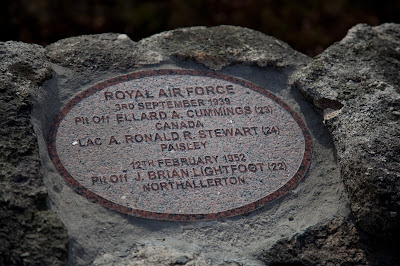The Muchalls Peace Sign – by Duncan Harley
As the wreaths pile up alongside the War Memorials on this Remembrance
Sunday and the bagpipes play Battle’s O’er at some 2,000 locations worldwide it
seems appropriate to remember that Scotland has its own Little Cenotaph sitting,
almost forgotten alongside the main railway-line between Newtonhill and Stonehaven.
Muchalls is described
in the 1884 edition of the Ordnance
Gazetteer of Scotland as: “a
village in Fetteresso parish, Kincardineshire, with a station on the
North-Eastern section of the Caledonian railway, 5 miles NNE of Stonehaven,
under which it has a telegraph and post office”.
The tiny settlement nowadays lacks a station but still sits alongside the railway-line which transported the men from the towns and the villages of Aberdeenshire to the battlefields of France and Belgium.
Charles Dickens is said to have described the village as a remarkably beautiful place and there are dark tales of a long-lost smuggler’s cave, haunted by a Green Lady, linking Muchals Castle to the nearby cliffs.
Today’s high speed trains still pass through the village and sharp-eyed passengers, might just snatch a glimpse of a concrete commemorative plaque on the trackside embankment with the words “Peace 1919” and emblazoned on it.
The 20ft long memorial is locally known as the Muchals Peace Sign and was dedicated in August 1919 to commemorate the signing of the peace treaty between the victorious allies and Germany on 28 June 1919. Designed by the then superintendent of Aberdeen’s Duthie Park, the plaque was completed in record time by a local firm of plasters and cement merchants. Fittingly perhaps, the use of cement for the plaque echoed the material used to build the original Cenotaph in Whitehall.
Edwin Lutyens' original timber and plaster Whitehall Cenotaph was hurriedly built as just one of a number of temporary ceremonial structures erected for the London Peace Day Parade on 19 July 1919 and was only later replaced by the more permanent structure built from Portland Stone which we see today.
The Muchals Peace Sign however was never upgraded and remains in its original form. Indeed, apart from an occasional makeover to remove weeds the plaque is a tribute not only to those who lost life and limb in that war to end all wars, but to the undeniable durability of Aberdeenshire concrete.
The tiny settlement nowadays lacks a station but still sits alongside the railway-line which transported the men from the towns and the villages of Aberdeenshire to the battlefields of France and Belgium.
Charles Dickens is said to have described the village as a remarkably beautiful place and there are dark tales of a long-lost smuggler’s cave, haunted by a Green Lady, linking Muchals Castle to the nearby cliffs.
Today’s high speed trains still pass through the village and sharp-eyed passengers, might just snatch a glimpse of a concrete commemorative plaque on the trackside embankment with the words “Peace 1919” and emblazoned on it.
The 20ft long memorial is locally known as the Muchals Peace Sign and was dedicated in August 1919 to commemorate the signing of the peace treaty between the victorious allies and Germany on 28 June 1919. Designed by the then superintendent of Aberdeen’s Duthie Park, the plaque was completed in record time by a local firm of plasters and cement merchants. Fittingly perhaps, the use of cement for the plaque echoed the material used to build the original Cenotaph in Whitehall.
Edwin Lutyens' original timber and plaster Whitehall Cenotaph was hurriedly built as just one of a number of temporary ceremonial structures erected for the London Peace Day Parade on 19 July 1919 and was only later replaced by the more permanent structure built from Portland Stone which we see today.
The Muchals Peace Sign however was never upgraded and remains in its original form. Indeed, apart from an occasional makeover to remove weeds the plaque is a tribute not only to those who lost life and limb in that war to end all wars, but to the undeniable durability of Aberdeenshire concrete.
Duncan Harley is
author of The A-Z of
Curious Aberdeenshire plus the forthcoming title: The
Little History of Aberdeenshire - due out on1st March 2019. Both titles can be ordered via
Amazon.











Comments
Post a Comment